Related Research Articles
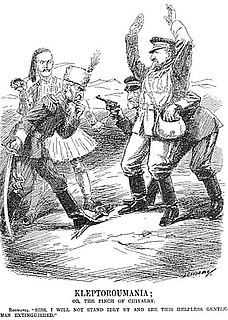
A pun, also known as paronomasia, is a form of word play that exploits multiple meanings of a term, or of similar-sounding words, for an intended humorous or rhetorical effect. These ambiguities can arise from the intentional use of homophonic, homographic, metonymic, or figurative language. A pun differs from a malapropism in that a malapropism is an incorrect variation on a correct expression, while a pun involves expressions with multiple interpretations. Puns may be regarded as in-jokes or idiomatic constructions, especially as their usage and meaning are usually specific to a particular language or its culture.
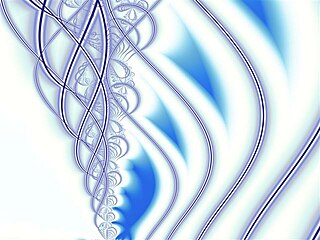
A holon is something that is simultaneously a whole in and of itself, as well as a part of a larger whole. In other words, holons can be understood as the constituent part–wholes of a hierarchy.

Darkness at Noon is a novel by Hungarian-born British novelist Arthur Koestler, first published in 1940. His best known work, it is the tale of Rubashov, an Old Bolshevik who is arrested, imprisoned, and tried for treason against the government that he helped to create.
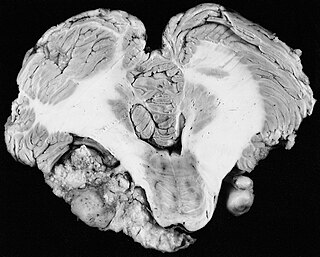
A vestibular schwannoma (VS), also called acoustic neuroma, is a benign tumor that develops on the vestibulocochlear nerve that passes from the inner ear to the brain. The tumor originates when Schwann cells that form the insulating myelin sheath on the nerve malfunction. Normally, Schwann cells function beneficially to protect the nerves which transmit balance and sound information to the brain. However, sometimes a mutation in the tumor suppressor gene, NF2, located on chromosome 22, results in abnormal production of the cell protein named Merlin, and Schwann cells multiply to form a tumor. The tumor originates mostly on the vestibular division of the nerve rather than the cochlear division, but hearing as well as balance will be affected as the tumor enlarges.
Spinal tumors are neoplasms located in either the vertebral column or the spinal cord. There are three main types of spinal tumors classified based on their location: extradural and intradural. Extradural tumors are located outside the dura mater lining and are most commonly metastatic. Intradural tumors are located inside the dura mater lining and are further subdivided into intramedullary and extramedullary tumors. Intradural-intramedullary tumors are located within the dura and spinal cord parenchyma, while intradural-extramedullary tumors are located within the dura but outside the spinal cord parenchyma. The most common presenting symptom of spinal tumors is nocturnal back pain. Other common symptoms include muscle weakness, sensory loss, and difficulty walking. Loss of bowel and bladder control may occur during the later stages of the disease.
The News Chronicle was a British daily newspaper. Formed by the merger of The Daily News and the Daily Chronicle in 1930, it ceased publication on 17 October 1960, being absorbed into the Daily Mail. Its offices were at 12/22, Bouverie Street, off Fleet Street, London, EC4Y 8DP, England.
A coincidence is a remarkable concurrence of events or circumstances that have no apparent causal connection with one another. The perception of remarkable coincidences may lead to supernatural, occult, or paranormal claims. Or it may lead to belief in fatalism, which is a doctrine that events will happen in the exact manner of a predetermined plan. In general, the perception of coincidence, for lack of more sophisticated explanations, can serve as link to folk psychology and philosophy.

The Ghost in the Machine is a 1967 book about philosophical psychology by Arthur Koestler. The title is a phrase coined by the Oxford philosopher Gilbert Ryle to describe the Cartesian dualist account of the mind–body relationship. Koestler shares with Ryle the view that the mind of a person is not an independent non-material entity, temporarily inhabiting and governing the body. The work attempts to explain humanity's self-destructive tendency in terms of individual and collective functioning, philosophy, and overarching, cyclical political–historical dynamics, peaking in the nuclear weapons arena.
Witzelsucht is a set of pure and rare neurological symptoms characterized by a tendency to make puns, or tell inappropriate jokes or pointless stories in socially inappropriate situations. It makes one unable to read sarcasm. A less common symptom is hypersexuality, the tendency to make sexual comments at inappropriate times or situations. Patients do not understand that their behavior is abnormal, therefore they are nonresponsive to others' reactions. This disorder is most commonly seen in patients with frontal lobe damage, particularly right frontal lobe tumors or trauma. The disorder remains named in accordance with its reviewed definition by German neurologist Hermann Oppenheim, its first description as the less focused moria by German neurologist Moritz Jastrowitz, was in 1888.
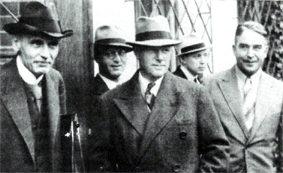
Otfrid Foerster was a German neurologist and neurosurgeon, who made innovative contributions to neurology and neurosurgery, such as rhizotomy for the treatment of spasticity, anterolateral cordotomy for pain, the hyperventilation test for epilepsy, Foerster's syndrome, the first electrocorticogram of a brain tumor, and the first surgeries for epilepsy. He is also known as the first to describe the dermatomes, and he helped map the motor cortex of the cerebrum.
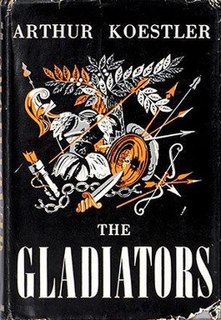
The Gladiators (1939) is the first novel by the author Arthur Koestler; it portrays the effects of the Spartacus revolt in the Roman Republic. Published in 1939, it was later reprinted in other editions.
Auditory verbal agnosia (AVA), also known as pure word deafness, is the inability to comprehend speech. Individuals with this disorder lose the ability to understand language, repeat words, and write from dictation. Some patients with AVA describe hearing spoken language as meaningless noise, often as though the person speaking was doing so in a foreign language. However, spontaneous speaking, reading, and writing are preserved. The maintenance of the ability to process non-speech auditory information, including music, also remains relatively more intact than spoken language comprehension. Individuals who exhibit pure word deafness are also still able to recognize non-verbal sounds. The ability to interpret language via lip reading, hand gestures, and context clues is preserved as well. Sometimes, this agnosia is preceded by cortical deafness; however, this is not always the case. Researchers have documented that in most patients exhibiting auditory verbal agnosia, the discrimination of consonants is more difficult than that of vowels, but as with most neurological disorders, there is variation among patients.
There are many theories of humor which attempt to explain what humor is, what social functions it serves, and what would be considered humorous. Among the prevailing types of theories that attempt to account for the existence of humor, there are psychological theories, the vast majority of which consider humor to be very healthy behavior; there are spiritual theories, which consider humor to be an inexplicable mystery, very much like a mystical experience. Although various classical theories of humor and laughter may be found, in contemporary academic literature, three theories of humor appear repeatedly: relief theory, superiority theory, and incongruity theory. Among current humor researchers, there is no consensus about which of these three theories of humor is most viable. Proponents of each one originally claimed their theory to be capable of explaining all cases of humor. However, they now acknowledge that although each theory generally covers its own area of focus, many instances of humor can be explained by more than one theory. Similarly, one view holds that theories have a combinative effect; Jeroen Vandaele claims that incongruity and superiority theories describe complementary mechanisms which together create humor.

Arthur Koestler, was a Hungarian British Jewish author and journalist. Koestler was born in Budapest and, apart from his early school years, was educated in Austria. In 1931, Koestler joined the Communist Party of Germany, but he resigned in 1938 because Stalinism disillusioned him.

The Act of Creation is a 1964 book by Arthur Koestler. It is a study of the processes of discovery, invention, imagination and creativity in humour, science, and the arts. It lays out Koestler's attempt to develop an elaborate general theory of human creativity.
Stranger on the Square is the third volume of Arthur Koestler's autobiography, published posthumously in 1984. It was co-authored with his wife Cynthia Koestler, née Jefferies, and includes autobiographical notes of her as well. The book was published by Hutchinson, London 1984, 242 pages including Index. ISBN 0-09-154330-4. It was edited by Harold Harris, who wrote the Introduction and Epilogue. He was Koestler's editor for many years. The book is illustrated with seven monochrome photographs plus a colour and another monochrome photograph on the dustcover.

Koestler Arts is a charity which helps ex-offenders, secure patients and detainees in the UK to express themselves creatively. It promotes the arts in prisons, secure hospitals, immigration centres and in the community, encouraging creativity and the acquisition of new skills as a means to rehabilitation. The Koestler awards were founded in 1962 and the organisation became a charitable trust in 1969 following a bequest from the British-Hungarian author, Arthur Koestler.
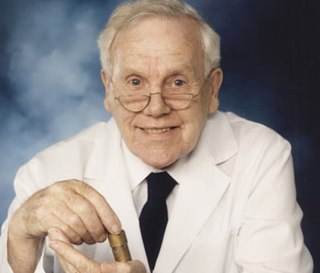
John Julian Cuttance Wild was an English-born American physician who was part of the first group to use ultrasound for body imaging, most notably for diagnosing cancer. Modern ultrasonic diagnostic medical scans are descendants of the equipment Wild and his colleagues developed in the 1950s. He has been described as the "father of medical ultrasound".

Standard Chinese, like many Sinitic varieties, has a significant number of homophonous syllables and words due to its limited phonetic inventory. The Cihai dictionary lists 149 characters representing the syllable "yì". Many Chinese take great delight in using the large amount of homophones in the language to form puns, and they have become an important component of Chinese culture. In Chinese, homophones are used for a variety of purposes from rhetoric and poetry to advertisement and humor, and are also common in Chinese loans, for example phono-semantic matching of brand names, computer jargon, technological terms and toponyms.

The history of cancer describes the development of the field of oncology and its role in the history of medicine.
References
- ↑ Koestler, Arthur: The Act of Creation - many editions, e.g. Arkana, ISBN 978-0-14-019191-2
- ↑ ARNMD (1940), Vol. XX, p.732, cited in Koestler